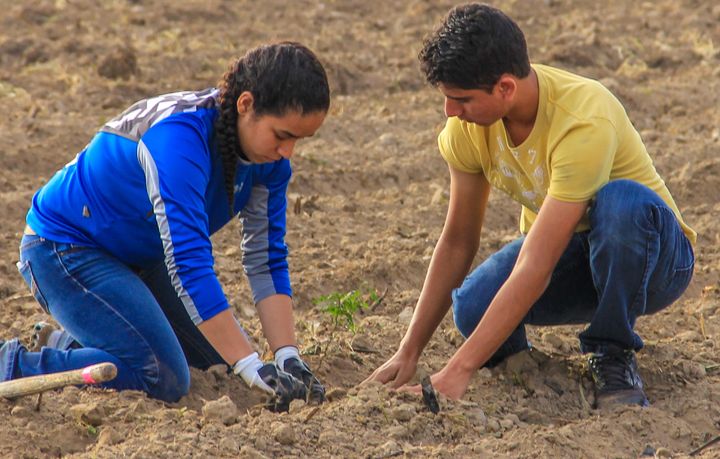
Restoring Forests on the Rio Grande
Planting a tree is a deeply hopeful act. Staring down at a newly planted tree seedling, we recognize an act of faith in our natural environment and a gift that will outlive us. Right now, in the wake of President Trump’s shocking decision to walk away from the Paris Climate Agreement, we need this kind of local empowerment more than ever to maintain progress against climate change.
The biggest barrier to climate progress has always been hopelessness. Climate change presents a “collective action problem” at a massive scale, and therefore requires a certain leap of faith for an individual, organization, or government to move forward without knowing what others will do, or even if our best collective efforts will be enough.
That is why the powerful tree planting movement welling up across America is so important right now. Hidden in plain sight, this movement is engaging people in planting tangible climate solutions from cities and towns to majestic forest landscapes damaged by fire, weather, pests and disease, or past legacies of over-harvesting and mining.
At a time when our country feels deeply divided, it really matters that everyone and anyone can participate in planting trees. Two examples highlight the diversity of these efforts:
- In Detroit, new community tree planting efforts are springing up to turn vacant properties into community assets. This includes the creation of tree nurseries that are a source of new jobs for underserved communities.
- In rural Bastrop County, Texas a volunteer-led effort has replanted forests devastated by wildfire, restoring habitat, economic opportunities, and natural carbon capture.
Mind you, embracing tree planting to slow climate change is not just a symbolic act meant to make us feel better. Trees are powerful carbon scrubbing devices, ready to deploy. In total, U.S. forests and forest products currently capture and store about 13 percent of total U.S. carbon emissions each year. This is roughly equivalent to the emissions reductions that were projected for the U.S. Environmental Protection Agency’s Clean Power Plan—reductions that might not happen now that the plan has been sidelined by the Trump administration. Tree planting can further boost carbon capture in our forests to make up for some of the backsliding on federal regulatory efforts.
By way of example, replanting just one acre of the carbon-hungry hardwood forests in the Lower Mississippi region will capture and store approximately 320 tons of carbon dioxide over the lifecycle of those trees. That is the carbon emissions equivalent of consuming 4.2 tanker trucks of gasoline, or burning 341,000 pounds of coal, according to the U.S. Environmental Protection Agency’s emissions equivalency calculator.
But it is not just our beautiful forested landscapes that help slow climate change. Street trees and urban forests provide almost 1/10th of the total carbon capture from U.S. forests. Urban tree canopy can also save energy used for cooling our homes and businesses, further reducing carbon emissions. One study estimated that 5-10 percent of electricity demand for air conditioning during peak periods results from “urban heat islands.” Planting trees within heat islands can help reduce this extra energy demand.
So how do we supercharge the tree planting movement?
Let’s start with perhaps the most unexpected source of leadership for tree planting: corporate America. Corporations have found increasingly diverse ways to support forests, ranging from purchasing offsets for a company’s carbon and paper footprint to engaging customers and employees as partners in planting trees.
Outdoor apparel retailer Eddie Bauer has provided one great example by partnering with my organization, American Forests, to plant more than 7 million trees and counting through the One Tree Initiative. The compelling tree planting examples provided above from Detroit and Bastrop County were also made possible by corporate partners—Bank of America and LightStream, respectively.
Government also has a major role to play. Despite shifts in federal climate policy, the U.S. Forest Service continues to lead important efforts to accelerate tree planting on national forests to speed recovery from fire, extreme weather, and other disturbances. This (literally) ground-breaking effort on the Monongahela National Forest in West Virginia is one example. The public-private partnership on the Monongahela is replanting the native red spruce forests of the Central Appalachian region by using innovative techniques to till up forest soils that were compacted by past mining activity and therefore unable to regenerate native forest.
States have also shown great leadership for tree planting, like Michigan’s effort to restore state forestland for the endangered Kirtland’s warbler. Michigan is investing in active forest management and accelerated tree planting to restore its native jack pine forests, which are critical to the recovery of the Kirtland’s warbler and also a source of carbon capture.
The key to the tree planting movement is continuing and even growing our collective investment of money, time, and human energy. There are many ways for people to jump in by joining local tree planting efforts, supporting tree planting organizations, and patronizing companies that are part of the effort.
Of equal importance, we must collectively call on government to invest more in tree planting. Despite the positive examples above, state and federal government agencies alike are struggling to keep up with tree planting needs and opportunities. President Trump’s recent budget proposal for Fiscal Year 2018 would further reduce funding from key sources, such as the U.S. Forest Service’s Urban and Community Forestry Program and Collaborative Forest Landscape Restoration Program.
Greater investment in tree planting should be an easy sell for individuals, organizations, and government alike. While healing our environment and climate, tree planting also forms powerful human connections—to land and nature, to community, to new job and volunteer opportunities, and much more. Tree planting is truly a “no regrets” investment in our country. Let’s double down on the tree planting movement to plant hope for our future.
